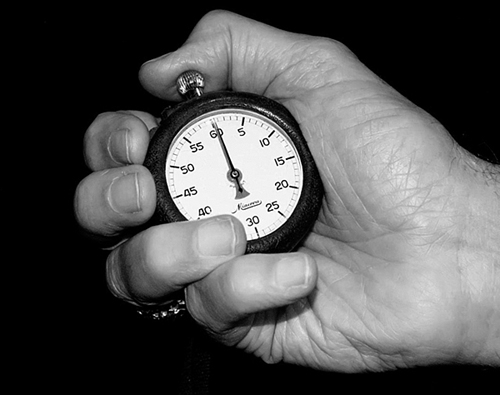3. How Long Should a Presentation Last?
I can well understand the Honourable Member’s wishing to speak on. He needs the practice badly.
—Sir Winston Churchill1
Be Brief and Concise

Every presenter is painfully aware of the short attention span of modern audiences. Jason Gay, who writes for the Wall Street Journal, captured the essence of the phenomenon perfectly:
You are busy, busy, busy! This is presumed in 2012. You are too hurried to pay cash for your coffee—oh, it’s so arduous, removing the bills from the pocket, unfolding them, handing them to the cashier, waiting for change, which can take up...to...nine...agonizing...seconds. So you pay with an app on your smartphone—blip, done.2
But short attention spans pre-date 2012; they go all the way back to the twentieth century.
President Franklin D. Roosevelt, one of America’s, if not the one of the world’s, most accomplished orators answered the question in the title of this chapter with his famous advice, “Be sincere, be brief, and be seated.”3
This wise counsel is sadly all too often ignored in most presentations where brevity is a rarity. FDR was referring to the length of a speech, but brevity is also important in regard to the amount of detail in a presentation.
James Collins, author of the novel Beginner’s Greek, addressed the subject in a New York Times Book Review essay titled “The Plot Escapes Me.” Mr. Collins described how much he likes to read books, but that once he finishes, “I remember nothing about the book’s actual contents...all I associate with them is an atmosphere and a stray image or two.” He went on to note that he is not alone, “most people cannot recall the title or author or even the existence of a book they read a month ago, much less its contents.”4
Curious about the phenomenon, Mr. Collins discussed it with Maryanne Wolf, a professor at Tufts University and Director of Center for Reading and Language Research. Professor Wolf validated the experience. “There is a difference,” she said, “between immediate recall of facts and an ability to recall a gestalt of knowledge. We can’t retrieve the specifics, but to adapt a phrase of William James’s, there is a wraith of memory.”
As important as controlling the amount of content is in written text, it is even more important in live presentations. Readers of text—whether in print or electronic form—can always go backward in the text to clarify details, but audiences for presentations—who receive the content in real time—do not have that option. If they lose track, they will either interrupt the presenter or tune out; at which point the presenter loses too.
The lesson for you is to be concise. Be mindful of not only the overall length of your presentation, but also the amount of detail you include and—just as important—how you organize those details. Craft your presentation with just three to five high level themes, and be sure that any information you include clearly relates to those themes. Then, as you present, keep referencing the themes and tying the details back to them. Your audience may forget the details after your presentation, but they will “recall a gestalt” of your story.
Or as Guy Kawasaki, that master of well-turned phrases, in his own variation of FDR’s advice, wrote in his book Enchantment, “Make it short simple and swallowable.”5
